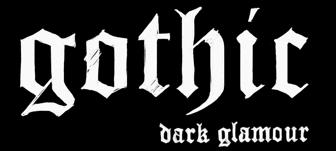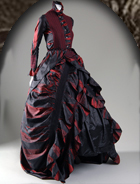

Mourning
Beginning with the rise of the gothic novel in the eighteenth century, gothic style has been associated with sublime themes of terror and the supernatural. The Victorian cult of mourning mandated head-to-toe black, inspiring members of the goth subculture – and contributing to the image of the femme fatale and the vamp.
Victorian mourning dress was supposed to symbolize grief and respect for the dead. Mourning weighed most heavily on widows, who were supposed to wear deep mourning for at least a year. Mourning clothes were made from fabrics wtih a lustreless texture such as crepe, but were not only black. During the second year of mourning, gray and violet clothes could be gradually introduced. Although Victorian etiquette books stressed that mourning dress should be "plain" and "simple," this injunction was contradicted by the fact that mourning, since it was a category of fashionable dress, was often extremely elaborate..
Within the constellation of gothic conventions, the fear of death is often transformed into a kind of sexually-charged horror. Death and decay are aestheticized and romanticized. Not only is the boundary blurred between life and death, so also is there a transgressive understanding of sex and gender. The widow could easily be perceived as a fatal woman, whose embrace led to her lover's death. The femme fatale was often, although not always, depicted in black. Silent films of the early twentieth century established the image of the black-clad vamp, as portrayed by actresses like Theda Bara.

